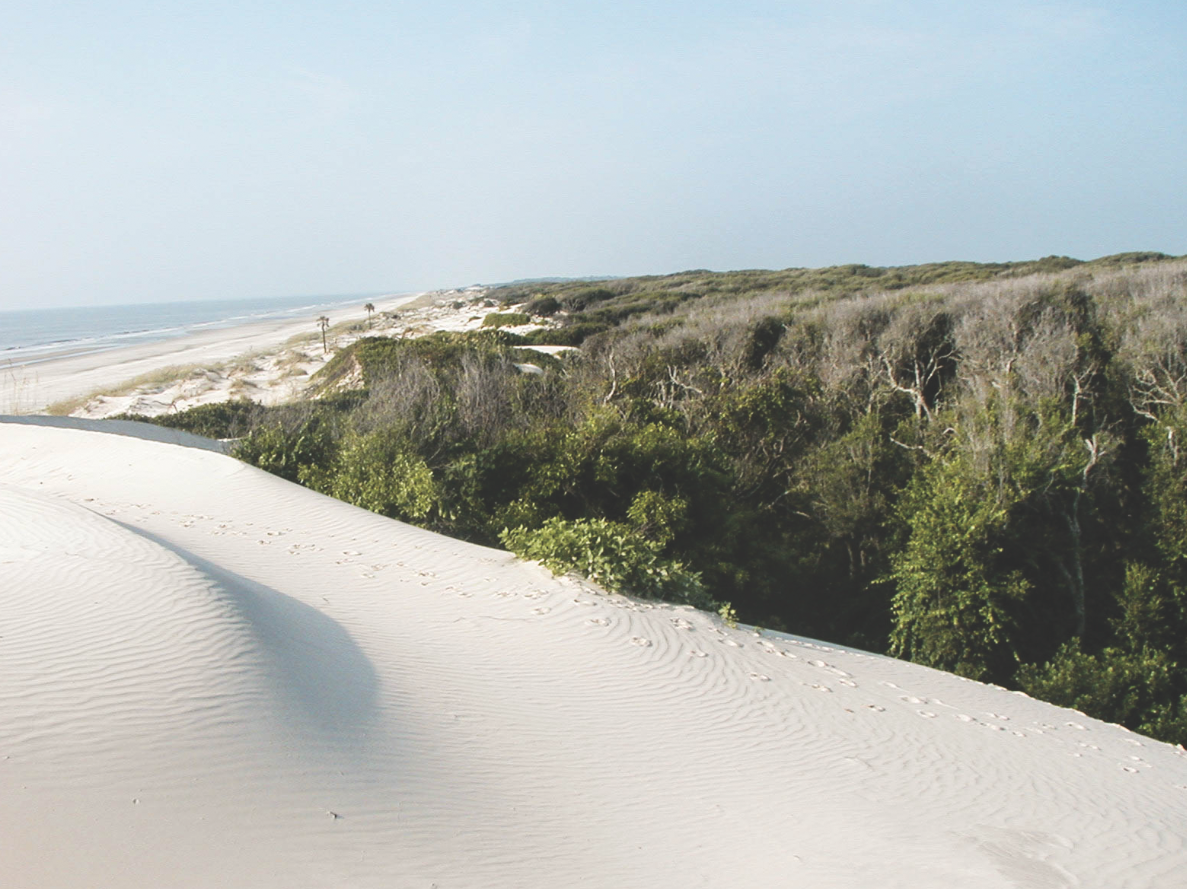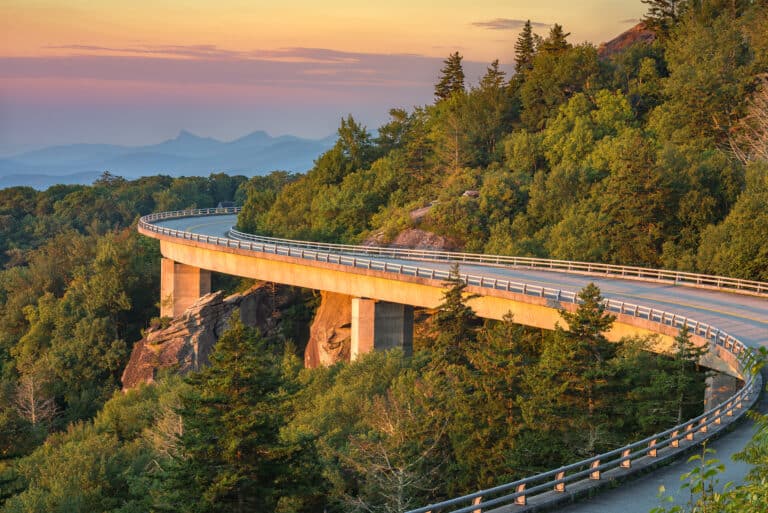“When you step off the ferry at Sea Camp, the first thing that strikes you is the silence,” says Alex Kearns, a frequent visitor to Cumberland Island National Seashore, Georgia’ largest and southernmost barrier island. “Then you hear the wind, and the distant thrum of the ocean, and you hear your breath for the first time.”
Less than a mile from the dock, you climb towering dunes and spill out onto a wide, windswept beach, where gulls and terns dance with the tides. Cumberland Island has no beachfront houses or developments, so you often have the entire seashore to yourself.
A few property owners are jockeying for permission to build on about 1,000 acres of private land still remaining on Cumberland Island National Seashore, including an 88-acre parcel right next to Sea Camp.
However, the island’s scenery and silence may soon change dramatically. A handful of wealthy island families are planning a beachfront development next to Sea Camp that could forever mar the wild, pristine seashore.
A few property owners are jockeying for permission to build on about 1,000 acres of private land still remaining on Cumberland Island National Seashore, including an 88-acre parcel right next to Sea Camp.
Those property owners are in the midst of negotiations with conservationists, the local county zoning board, and the National Park Service, which owns a vast majority of the island and oversees management and visitation of the park.
“To rezone those 1,000 acres for development is to create a blueprint for destruction of the island,” says Kearns.
PARADISE LOST?
The 88-acre property planned for development stretches across the width of the island just north of Sea Camp Campground, from the ferry dock to the beach. It is adjacent to the island’s most accessible and most visited campground.
Lumar Limited Liability Corporation, a company formed in 1997 to buy and hold property and conceal the identity of its owners, purchased the tract in 1998 for $3.5 million from Georgia Rose Rockefeller, a descendent of the Carnegie family, which collectively owned 90 percent of the island at one time. Lumar, LLC, includes members of the Candler family, descendents of Coca-Cola founder Asa Candler, which have also owned land on the island for several generations. The Candler family currently live in several houses on nearly 1,000 acres on the north end of Cumberland Island.
Reverend Sam Candler of St. Philip’s Cathedral in Atlanta has spoken publicly about his family’s intentions with the Lumar property, which according to him are only around ten homes for his current and future family. He says his family wants to build “unobtrusive” homes invisible to the eye of any hikers and campers recreating nearby.
But most hikers and outdoor organizations worry that any new second-home developments in a national park would be bad for the island.
“Development will lead to more people and vehicle traffic on the beach,” says Carol Ruckdeschel, an island naturalist. “The development will require roads, septic systems, well drilling, and infrastructure for garbage. Taken in total, the impact is going to be a lot larger than a few houses, and they will permanently change the character of Cumberland.”
[nextpage title=”Read on!”]
THE EVOLUTION OF A PARK
Congress established Cumberland Island National Seashore in 1972 in order to “maintain the primitive, undeveloped character of one of the largest and most ecologically diverse barrier islands on the Atlantic Coast,” according to its founding legislation.
The National Park Service purchased most of the parcels on the island from private landowners, offering many of them a sweetheart deal: the Park Service would buy the land (in many cases, for millions of dollars), maintain roads, build docks and haul trash, and the families would be allowed to live on the island for the rest of their lives, or a set number of years, depending on the agreement.
That founding legislation also gave the National Park Service the power of eminent domain over the island, meaning they could legally condemn properties to better conserve and manage the national seashore. It’s a tool that the Park Service used to acquire several tracts on Cumberland Island from non-Carnegie landowners.
But two wealthy Carnegie families were allowed to keep their private land within the national park: the family who operates the only commercial entity on the island, Greyfield Inn, and another Carnegie heir who sold 88 acres to Lumar, LLC for development next to Sea Camp.
“The intention of the island’s founding legislation was that the Park Service would eventually own all the land on Cumberland Island,” says Cumberland Island National Seashore Superintendent Gary Ingram. “And that’s a good goal to have, especially when you’re trying to manage a wild place like Cumberland Island,” he said.
So far, the Park Service has been reluctant to use eminent domain to acquire the remaining 1,000 acres of Carnegie inholdings, but it’s a tool that the Park Service used to create the national seashore—and a tool they could use again to save it from development.
“I sold under threat of condemnation,” explains Ruckdeschel, who sold her parcel to the National Park Service in the 1970s and has rights to live on the island until she dies. “How equitable is it to now allow the wealthiest landowners to keep their property and actually develop the island while many others were condemned?”
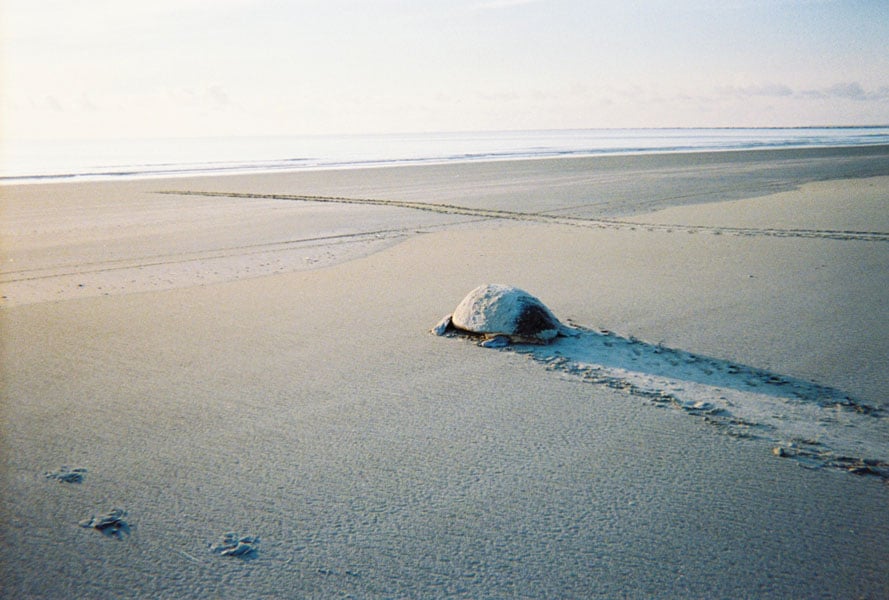
BUY IT BACK?
Superintendent Ingram said if property owners were willing to sell the remaining private land, including the 88 acres next to Sea Camp owned by Lumar, LLC, he’s certain the National Park Service could find money from partner conservation entities to purchase it.
It would be a win-win: Lumar would be recognized and compensated for providing a critically important tract of land next to Sea Camp, and the park and the general public would have ensured the long-term protection of the seashore.
But Sam Candler says he is not interested in selling. “That property…remains in the hands of families who have had a long-standing and sensitive history of caring for the island; I believe that is fortunate for the island,” Candler wrote in an email to Blue Ridge Outdoors.
Instead, Candler and Lumar LLC have been pressing the local Camden County zoning board to grant them a variance that will allow them to subdivide the property. Camden County approved the request, much to the dismay of conservation groups and island observers, including Southern Environmental Law Center Lead Attorney Bill Sapp. Sapp has led a multi-organization appeal of the granted variance, claiming that none of the standards required for approval were met.
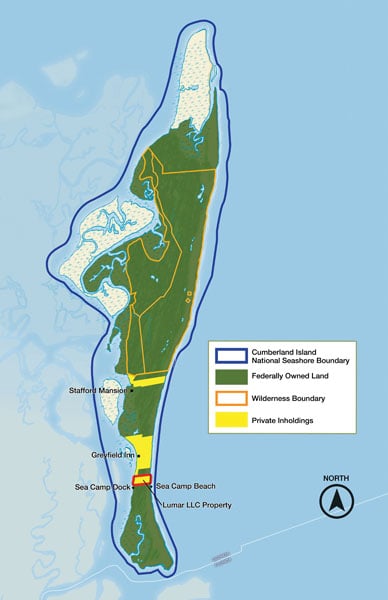
The appeal hearing was delayed several times until April, when Sapp, representatives of Lumar, LLC, Camden County officials, and the National Park Service began negotiations to consider a new zoning designation for the private properties on Cumberland Island.
PUBLIC LANDS, PRIVATE PLAYGROUND
So far, most of the negotiations are not aimed at stopping any current or future development but limiting the number of houses built per acre. Lumar, LLC wants a zoning rule of one house per two acres, which would allow for over 400 additional houses on Cumberland Island.
Superintendent Ingram hopes the negotiations can achieve a compromise that has the least amount of island impact.
“When the development footprint grows, there will be consequences. What the level of impact will be, I don’t know. If they’re building one structure out there, like a cabin, it’s far less than if they were building multiple 4,000-square-foot structures,” he said.
Kearns believes the negotiations are failing the taxpaying American public, who have already spent millions to purchase Cumberland Island.
She says that even the strictest limit currently on the table—one house per 25 acres—would still permit 40 additional developments within Cumberland Island National Seashore—more than twice the number of current residences on the island.
Kearns believes the negotiations are failing the taxpaying American public, who have already spent millions to purchase Cumberland Island.
“No matter what density the county chooses, the island will be permanently scarred and degraded long-term if development is allowed to proceed.”
Candler said the private landowners on the island, including his family, have been instrumental in preserving the island’s natural majesty, and for that reason, people should trust that relationship will continue. He said the island is big enough to accommodate additional development, with the less developed wilderness section on the north end of the island providing ecological benefits that allow for more homes on the south end without disturbing a visitor’s island experience substantially.
“I want to appeal to those elements of the public who have been on the island and who understand the historic and sensitive way that Cumberland has been sustained by a respectful partnership between the public and private sectors,” wrote Candler. “Most people who have been on Cumberland realize how large the island is. There are certainly areas which have houses on them, but the tremendous majority of the island will always remain without houses,” he said.
Superintendent Ingram has a different perspective.
“It’s a relatively small island. Any development has impacts. What level those impacts will have we don’t know right now. But it’s not just the human impacts of the development. There is also an environmental one too,” he said.
[nextpage title=”Read on!”]
RIPPLE EFFECT
Many businesses in St. Mary’s rely directly on Cumberland Island visitors to support their businesses. Former Mayor and longtime co-owner of the Riverview Hotel, which sits directly across the street from the island ferry dock, Jerry Brandon, said 90 percent of his business is Cumberland related.
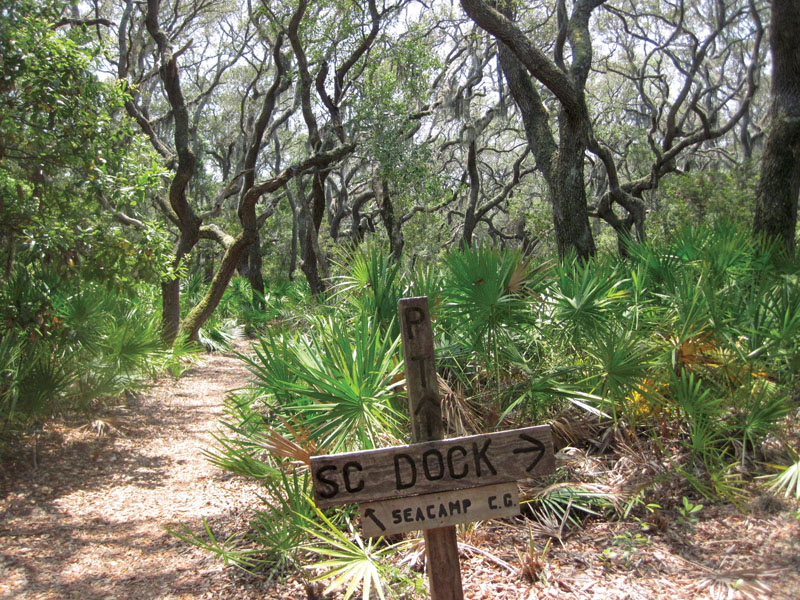
“If they start building houses on the middle of the island, that’s going to have a detrimental effect on tourism, and certainly to the purpose of the park, which means we’ll probably lose business,” he said.
Brandon was especially concerned that once rules were changed regarding potential development on the island, future generations of Candlers could push for even more and larger-scale developments. That could spell trouble for the island, he said.
The same wealthy families who have been claiming that they ‘saved’ Cumberland are now saying they want to rape it some more.—Carol Ruckdeschel
Negotiations between developers, conservation groups, and the Park Service are ongoing, and no official deadline has been set. With the power of eminent domain, the National Park Service could act on behalf of the public, the original Congressional intent for Cumberland, and the long-term future of the island.
“Acquiring the remaining private land on Cumberland Island is probably the most important step that the Park Service can take to protect the future of the national seashore,” says Kearns.
However, Candler believes that private property rights should trump the concerns of the general public.
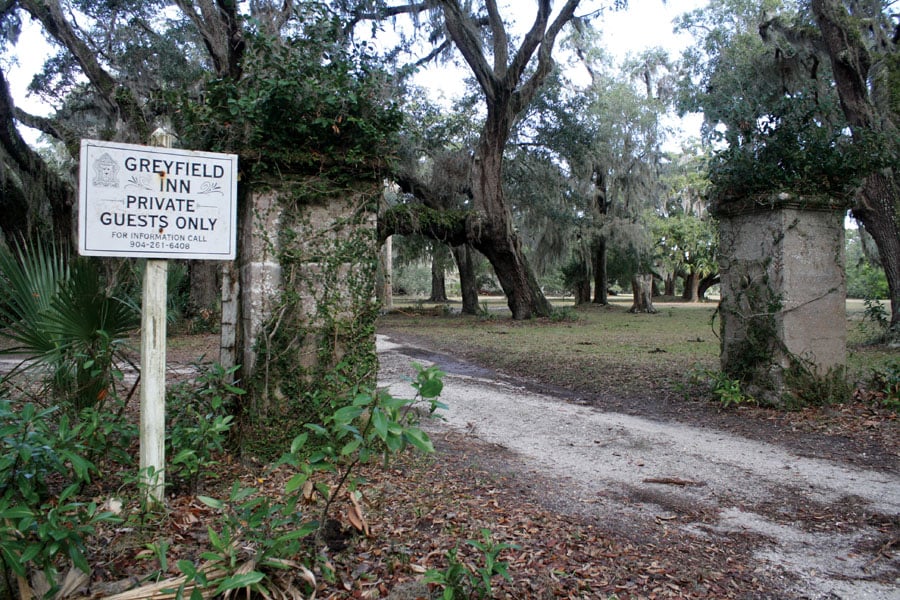
“On Cumberland, I observe that some elements of the public want to let all the present houses on the island fall into ruin. Other elements of the public want to respect the rights of private property owners, wherever that property is,” he wrote. “Cumberland Island is…both public and private. Some of us have no history at all there, and some of us have a long history there. None of us should be embarrassed about being there.”
Another resident and former property owner, Ruckdeschel, acknowledges that Candler’s desire to build more houses on Cumberland is understandable, but protection of one the country’s last wild islands should take priority over private vacation homes.
Says Ruckdeschel, “The same wealthy families who have been claiming that they ‘saved’ Cumberland are now saying they want to rape it some more.”
